And Then There Were None Guest Profile
And Then There Were None is a detective fiction novel past Agatha Christie, start published in the Uk by the Collins Crime Club on 6 November 1939 under the title Ten Petty Ni**ers, later on edited to Ten Little Indians, and in the United states of america by Dodd, Mead and Company in Jan 1940 nether the championship So There Were None. In the novel, ten people, who have previously been complicit in the deaths of others simply have escaped notice and/or punishment, are tricked into coming onto an isle. Even though the guests are the only people on the isle, they are all mysteriously murdered one by one, in a way paralleling, inexorably and sometimes grotesquely, the one-time nursery rhyme, "Ten Little Indians". The Uk edition retailed at seven shillings and sixpence (vii/6) and the Usa edition at $ii.00. The novel has as well been published and filmed under the title Ten Little Indians .
It is Christie's best-selling novel with 100 million sales to date, making information technology the world's acknowledged mystery and the 7th most popular book of all time. It has been adjusted into several plays, films, and a video game.
Plot summary
Eight people of different social classes: Mr. Marston, General MacArthur, Miss Emily Brent, Justice Wargrave, Dr. Armstrong, Ex-inspector Blore, Mr. Lombard and Miss Vera Claythorne have been invited to a mansion on the fictional Soldier Isle ("Ni**er Island" in the original 1939 U.k. publication, "Indian Island" in the 1940 Us publication), which is based upon Burgh Island off the coast of Devon.
Upon arriving, they are told that their hosts, a Mr. and Mrs. U.Due north.Owen (Ulick Norman Owen and Una Nancy Owen), are currently abroad, but that the guests will exist attended to past Thomas and Ethel Rogers. Each invitee finds in his or her room an odd scrap of bric-a-brac and a framed copy of the nursery rhyme "Ten Little Soldiers" ("Ni**ers" or "Indians" in respective earlier editions) hanging on the wall.
X little Soldier boys went out to dine;
1 choked his little self and then there were nine.
9 little Soldier boys sabbatum up very belatedly;
One overslept himself and then there were eight.
Eight little Soldier boys traveling in Devon;
One said he'd stay there so there were seven.
7 little Soldier boys chopping up sticks;
1 chopped himself in halves and so at that place were six.
Vi piddling Soldier boys playing with a hive;
A bumble bee stung one and so there were five.
Five piddling Soldier boys going in for police force;
One got in Chancery and then there were iv.
Four little Soldier boys going out to sea;
A carmine herring swallowed ane and and then there were three.
Iii little Soldier boys walking in the zoo;
A big bear hugged one and so there were two.
2 Little Soldier boys sitting in the sun;
One got frizzled up and so at that place was one.
One trivial Soldier male child left all alone;
He went and hanged himself and so in that location were none.
Before dinner that evening, the guests detect ten soldier (etc.) figurines on the dining room tabular array. During the meal, a gramophone record plays, informing the ten that each is guilty of murder. Each guest acknowledges awareness of (and, in some cases, involvement with) the deaths of the persons mentioned, but denies either malice and/or legal culpability.
The guests realize they have been tricked into coming to the island, simply find that they cannot leave: the gunkhole which regularly delivers supplies has stopped arriving. They are murdered one past one, each murder paralleling a poetry of the nursery rhyme, and one of the ten figurines being removed after each murder.
First to die is Anthony Marston, whose drink is poisoned with cyanide ("one choked his piffling self"). That night, Thomas Rogers notices that a figurine is missing from the dining tabular array. Mrs. Rogers dies in her sleep that night, which Dr. Armstrong attributes to a fatal overdose of sleeping draught ("one overslept himself"). General MacArthur fatalistically predicts that no one will leave the island alive, and at lunch, is indeed institute expressionless from a blow to the back of the skull ("one said he'd stay there"). Meanwhile, two more figurines take disappeared from the dining room. In growing panic, the survivors search the island in vain for the murderer. Justice Wargrave establishes himself as a decisive leader of the grouping and asserts that one of them must exist the murderer playing a sadistic game with the residuum. The killer's twisted sense of humour is evidenced by the names of their "hosts": "U.N. Owen" is a pun on "unknown". The adjacent forenoon, Rogers is missing, every bit is another figurine. He is found expressionless in the woodshed, struck in the head with an axe ("one chopped himself in halves"). Afterwards that mean solar day, Emily Brent is killed in the kitchen by an injection of potassium cyanide that leaves a mark on her cervix ("a bumblebee stung ane"). The hypodermic needle is institute outside her window next to a smashed people's republic of china figurine. The five survivors — Dr. Armstrong, Justice Wargrave, Philip Lombard, Vera Claythorne, and ex-Inspector Blore — get increasingly frightened.
Wargrave suggests they lock up whatever potential weapons, including Armstrong's medical equipment and the judge'south ain sleeping pills. Lombard admits to bringing a revolver to the island but says it has gone missing. Resolved to go along the killer from catching anyone solitary, they assemble in the cartoon room and but leave ane at a time. Vera goes up to her room and discovers a strand of seaweed: an allusion to the male child the gramophone alleged she had drowned. Her screams concenter the attention of Blore, Lombard, and Armstrong, who rush to her aid. When they return to the drawing room, they detect Wargrave in a mockery of a judicial wig and gown with a gunshot wound in his brow ("1 got into Chancery"). Armstrong confirms the expiry, and they lay Wargrave's body in his room. Shortly subsequently, Lombard discovers his revolver has been returned.
That night, Blore hears someone sneaking out of the house. He and Lombard investigate and, discovering Armstrong missing, presume the doctor is the killer. They wake Vera and the 3 spend the night outdoors. In the forenoon, Blore leaves for food and does not return. Vera and Lombard soon discover his body on the front lawn, skull crushed by a bear-shaped clock ("a large bear hugged one")—and on the shore, Armstrong, drowned ("a red herring swallowed one").
Paranoia overriding logic [neither could have killed Blore], each assumes the other is the murderer. In the tense standoff that follows, Vera feigns compassion and has Lombard aid her move Armstrong's body out of the water, using the opportunity to relieve him of his revolver. She kills Lombard on the embankment ("sitting in the lord's day") and returns to the business firm. Dazed and disoriented, Vera is unsurprised to find a noose prepared in her room. In a trance of exhaustion, guilt, and relief, she hangs herself, fulfilling the final verse of the rhyme.
Epilogue
The detective in charge of the Soldier Island case, Inspector Maine, discusses the mystery with his Banana Commissioner, Sir Thomas Legge, at Scotland Chiliad. There are no clues on the mainland — the man who arranged "U.Northward. Owen'south" buy of the island covered his tracks well, and was killed the solar day the party set sail—and while guests' diaries and coroner'southward report help plant a fractional timeline for the first six victiums from Marstan to Wargrave, the constabulary cannot determine the club in which Blore, Armstrong, Lombard, and Vera were killed: Inclement weather would have prevented the murderer from leaving or arriving separately from the guests: he or she must take been amongst them; however the paradox evidence is that someone was live afterward the terminal iv victiums were killed -which is incommunicable: Blore could not accept dropped the clock on himself; Armstrong'south body was dragged above the high-tide mark; Lombard was shot on the beach, simply his revolver was plant outside Wargrave'south room. Lombard's gun having Vera'due south fingerprints and the clock that killed Blore came from her room bespeak to Vera as "U.N.Owen"-nevertheless bear witness that someone was notwithstanding alive later on Vera'due south suicide is that the chair Vera used to hang herself had been righted and replaced against the wall. Yet all the murders appear to be accounted for, and the inspectors are baffled.
Postscript
A fishing trawler finds a letter of the alphabet in a canteen just off the Devon coast: the confession of the late Justice Wargrave. He reveals a lifelong sadistic temperament juxtaposed uneasily with a tearing sense of justice: he wanted to torture, terrify, and kill, but could never justify harming an innocent. As a gauge, he directed merciless summations and guilty verdicts but limited to those cases in which he has satisfied himself of the guilt of the accused(s), thrilling at the sight of the bedevilled person crippled with fear, facing their impending death. Merely the proxy of the bench was unsatisfying: Wargrave longed to commit murder by his own hand. Prompted to activeness by the discovery that he was terminally ill, he sought killers who had escaped justice and lured them to the island. Every bit he killed them one by one, he revealed in the mounting terror of those who remained, their reactions to the murders confirming their guilt to his extensive judicial experience. He also kills the guests by order of their level of guilt, first killing those whose crimes were less straight or out of carelessness, or who felt some level of remorse and saving the most cold-blooded killers for last.
Having tending of the first five guests, the gauge and so persuaded the trusting Armstrong to imitation Wargrave's ain decease, "the ruddy herring", nether the pretext that it would rattle the "real murderer". That night, he met Armstrong on the cliffs and pushed him into the sea, knowing the doctor'south disappearance would provoke the suspicions of the others. From Vera's room, Wargrave pushed the stone carry-shaped clock onto Blore, crushing his skull. He then watched Vera shoot Lombard. He also watched as Vera hanged herself. Wargrave pushed the chair she stood on against the wall, wrote out his confession, put the letter of the alphabet in a bottle and tossed it out the bounding main. Wargrave admits to craving posthumous recognition of his scheme. Even if his alphabetic character is not found, he argues that iii clues exist implicating him, although he surmises (correctly) that the mystery volition non take been solved:
- Wargrave was the just one invited to the island who had not wrongfully caused someone'southward expiry. Edward Seton, whom the gramophone defendant Wargrave of wrongfully sentencing to death, was, in fact, guilty of the murder for which he was convicted, and overwhelming proof emerged, albeit posthumously, of this. Thus, ironically,by paradox reasoning, the only "innocent" invitee must be the murderer!
- The "ruby herring" line in the poem suggests that Armstrong was tricked into his death by someone he trusted. Of the remaining guests, just the respectable Justice Wargrave would have inspired the physician's conviction.
- The red mark on Wargrave'due south forehead that Armstrong confirmed every bit a bullet wound is like to the one God bestowed upon Cain as punishment for killing his blood brother Abel [i.e. Cain being the first "murderer" in history-thus Wargrave "wound" points to him every bit "U.Due north. Owen"!]
Wargrave describes how he plans to kill himself: he will loop an rubberband string through the gun, tying ane stop of the cord to his eyeglasses, and looping the other effectually the doorknob of an open door. He will then wrap a handkerchief effectually the handle of the gun and shoot himself in the caput. His trunk will fall dorsum every bit though laid at that place by Armstrong. The gun's recoil will send information technology to the doorknob and out into the hallway, detaching the cord and pulling the door closed. The cord will dangle innocuously from his glasses; the stray handkerchief should not arouse suspicion. Thus the law will find ten dead bodies and an unsolvable mystery on Soldier Isle.
Club of the Deaths
Wargrave rated his victims' caste of guilt leaving the worst for last so they would suffer most. Marston, a mindless too equally conscienceless killer by carelessness is put downwardly kickoff similar a dangerous animal. Mrs. Rogers, the tool of her husband, is given a relatively merciful decease as is General MacArthur whose crime was 1 of passion. Mr. Rogers, a killer for proceeds, suffers a bloody expiry and Miss Brent, the cocky-righteous killer, is on the verge of breakup before she dies. The terminal 5 are all guilty of betraying a trust; Dr. Armstrong killed a patient by his drunken negligence; Blore, a police officeholder, gave false testimony confronting an innocent man; Lombard betrayed men under his control, colored or not; only Wargrave judged Vera Claythorne the worst of the lot for killing a kid in her care.
Characters
The following details of the characters are based on the original novel. Stage and film adaptations have often varied with names and backgrounds, such as Judge Wargrave being renamed Quinncannon and Lombard accused of causing the death of his pregnant girlfriend.
The x
- Anthony James Marston, a good-looking man with a well-proportioned torso, crisp hair, tanned face and blue optics known for his reckless driving, drunkeness and amoral behavivor. He was built-in to a wealthy family. Mr. Owen accused Anthony of running over and killing ii children. Marston not only felt no remorse he couldn't even remember the incident. Instead, he was more interested in how he had been suspended from driving. He was the first of Owen's victims, poisoned by potassium cyanide slipped into his drinkable.
- Mrs. Ethel Rogers, the cook, and Mr. Rogers's wife. She is described as a stake-faced, ghostlike adult female with shifty light eyes, who is scared easily. Despite her respectability and efficiency, she was obliged to assist her domineering husband, Thomas, to kill their former elderly employer, Miss Jennifer Brady, past withholding her medicine, in gild to inherit her money. The terrified and remorseful Mrs. Rogers is the second victim dying a merciful death in her sleep.
- Full general John Gordon MacArthur, a retired World State of war I hero, who sent his wife'southward lover, Arthur Richmond (also a soldier), to his death past assigning him to a "suicide" mission. Despite getting away with information technology, MacArthur's actions were suspected by a fellow soldier, and Wargraves later heard of the story from two onetime soldiers at his club. Of all the victims he comes the closest to experiencing 18-carat remorse for what he had done. He fatalistically accepts that no one will leave the island alive and is bluntly relieved that his sufferings of conscience and social ostracism volition finally stop. He is Owen's tertiary victim, his head crushed past a rock in as he sat solitary on the shore.
- Mr. Thomas Rogers, the butler and Mrs. Rogers'south husband. He and his weak-willed wife, whom he dominated, killed their sometime elderly employer by withholding her medicine, causing the elderly adult female to die from heart failure, to inherit the coin she had left them in her will. The fourth victim, he was killed with an axe while chopping woods.
- Emily Caroline Brent, a rigid, repressed elderly woman of harsh moralistic principles who uses the Bible to justify her cruelty. She dismissed her maid, Beatrice Taylor, as punishment for becoming pregnant out of wedlock. Beatrice then throws herself into a river and drowns. Miss Brent feels no guilt but as the tension mounts, she is haunted by the retentivity of the dead girl. She was Owen'southward fifth victim, killed by an injection of potassium cyanide into her neck every bit she sat lonely at the dining table.
- Justice Lawrence Wargrave, a retired judge, well known for liberally handing out the death punishment. He is defendant of murder due to his summation and jury directions of ane defendant murderer Edward Seton, although there were some doubts most his guilt at the time of the trial. He was thought to be the sixth victim of Owen in order to fulfill the Chancery verse but was later revealed to have been Mr. Owen. He did, all the same, shoot himself in the head after watching Vera Claythorne hang herself.
- Dr. Edward George Armstrong, a Harley Street surgeon, blamed for the death of Ms. Louisa Clees, a patient, while operating under the influence of booze. Similar the other victims, Armstrong feels no truthful remorse, his only concern being the effect the death may have had on his career. Armstrong became Owen'due south seventh victim subsequently existence pushed into the sea to his expiry. His body goes missing for a while, leading others to recall he is the killer, but his corpse washes upwards at the terminate of the novel, leading to the climax.
- William Henry Blore, a retired police inspector and now a private investigator, is accused of having testified in court confronting an innocent man, James Landor, sentenced to lifetime imprisonment for a banking company robbery/murder equally a scapegoat after Blore had been compromised past a unsafe criminal gang. The man afterward died in prison. He first denies his guilt just later privately admits that it was truthful just to Lombard. Blore became Owen's eighth victim, having his skull crushed in with a behave-shaped clock when he returned to the house unattended.
- Philip Lombard, a soldier of fortune. Literally down to his last square repast, he comes to the island with a loaded revolver. Though he is reputed to be a good human in a tight spot, Lombard is defendant of causing the deaths of a native African tribe. Information technology is said that he stole nutrient from the tribe, thus causing their starvation and subsequent death. Smiliar to MArtson he admits that the accusation against him is true but shows no remorse. Of all the "Guests" he suspects Wargrave is U.N. Owen merely information technology doesn't help him at all.Though not an actual victim of Owen's, Lombard was shot to death by Vera, who at the time believed him to be the murderer.
- Vera Elizabeth Claythorne, an ex-governess, she came to Soldier Island with a offer of a secretarial task which she considers meliorate than her nowadays occupation which is a game mistress at a 3d grade girls school; her last chore equally a governess ended in the expiry of her charge. Presented every bit a calm, rational and absurd woman, Vera lost control only once in the novel, and she became hysterical and was slapped. Later, she was angry with herself for losing command. She allow young Cyril Hamilton swim out to bounding main and drown so that his uncle, Hugo Hamilton, could inherit his money and ally her; even so, the plan backfired, as Hamilton abandoned her when he suspected what she had done. Vera seems to be tormented past guilt but in fact, it is simply grief for being constitute out and losing the man she loved. She is made to suffer the most, being the last survivor. She eventually meets her demise when she walks dorsum to her room after shooting Lombard. In that location she finds a readied noose, complete with a chair below information technology, suspended from her ceiling. Guilt-ridden and delusional, believing her love, Hugo, is upstairs waiting for her to pass judgment, Vera climbs the chair, adjusts the noose effectually her neck, and kicks the chair abroad, fulfilling the rhyme's final verse.
Pocket-sized characters
- Sir Thomas Legge and Inspector Maine, two policemen who hash out the case in the epilogue.
- Isaac Morris, the human who is hired by Mr. Owen and arranges for Phillip Lombard to come to the island and meet Mr. Owen for a afterwards payment of 100 Guineas {105 GBP} to Lombard. Isaac Morris, every bit mentioned in the postscript of the book, dies when he takes what is thought to exist a pill to help him with his "gastrial juices" given to him by Mr. Owen. His law-breaking was to have supplied a immature woman with the illegal drugs that caused her death.
- Fred Narracott, the boatman who delivered the guests to the island. Later doing so he doesn't appear over again.
Publication history
The novel was originally published in United kingdom of great britain and northern ireland nether the title Ten Little Ni**ers in 1939. All references to "Indian" in the story were originally "Ni**er": thus the island was called "Ni**er Island" rather than "Indian Isle" and the rhyme plant past each murder victim was also called Ten Little Ni**ers rather than Ten Niggling Indians. Mod printings utilise the rhyme Ten Little Soldiers and "Soldier Island" for reasons of political and ethnic sensitivity.
The UK serialization was in twenty-three parts in the Daily Limited from Tuesday, June 6 to Sabbatum, July 1, 1939. All of the installments carried an illustration by "Prescott" with the first installment having an illustration of Burgh Island in Devon which inspired the setting of the story. This version did non incorporate any chapter divisions.
For the United States market place, the novel was beginning serialized in the Saturday Evening Post in vii parts from 20 May (Volume 211, Number 47) to 1 July 1939 (Volume 212, Number 1) with illustrations by Henry Raleigh and then published separately in book class in January 1940. Both publications used the less inflammatory title And Then In that location Were None. The 1945 motion motion-picture show likewise used this title. In 1946, the play was published under the new title Ten Little Indians (the same title under which it had been performed on Broadway), and in 1964 an American paperback edition also used this title.
British editions connected to utilize the work'southward original title until the 1980s and the commencement British edition to utilize the alternative championship So In that location Were None appeared in 1985 with a reprint of the 1963 Fontana Paperback. Today And Then There Were None is the title most commonly used. Withal, the original championship survives in many foreign-language versions of the novel: for case, the Greek title is Δέκα Μικροί Νέγροι, the Bulgarian championship is Десет малки негърчета, the Spanish title is Diez negritos, the French title is Dix petits nègres and the Hungarian championship is Tíz kicsi néger, while the Italian title, Dieci piccoli indiani, mirrors the "Indians" title. A Dutch translation of 1981 used the piece of work'southward original English language title X Niggling Ni**ers The 19/ Russian film adaptation has the title Десять негритят (Desyat Negrityat). The calculator adventure game based on the novel uses "Ten Piddling Crewman Boys".
- Christie, Agatha (November 1939).Ten Little Ni**ers. London: Collins Criminal offense Guild. OCLC 152375426. Hardback, 256 pp.(Starting time edition)
- Christie, Agatha (January 1940).And then In that location Were None. New York: Dodd, Mead. OCLC 1824276. Hardback, 264 pp.(Offset The states edition)
- 1944, Pocket Books, 1944, Paperback, 173 pp (Pocket number 261)
- 1947, Pan Books, 1947, Paperback, 190 pp (Pan number iv)
- 1958, Penguin Books, 1958, Paperback, 201 pp (Penguin number 1256)
- Christie, Agatha (1963).And And so There Were None. London: Fontana. OCLC 12503435. Paperback, 190 pp. (The 1985 reprint was the first UK publication of novel under the championshipAnd Then In that location Were None).[14]
- Christie, Agatha (1964).Ten Little Indians. New York: Pocket Books. OCLC 29462459. (first publication of novel asX Lilliputian Indians)
- 1964, Washington Foursquare Press (paperback – teacher's edition)
- Christie, Agatha (1977).Ten Fiddling Ni**ers (Greenway edition ed.). London: Collins Criminal offence Club. ISBN 0-00-231835-0. Nerveless works, Hardback, 252 pp (Except for reprints of the 1963 Fontana paperback, this was i of the last English-language publications of the novel under the title "10 Little Ni**ers")<sup**lass="reference" id="cite_ref-15" style="line-peak:1em;unicode-bidi:-webkit-isolate;">[xv]
- Christie, Agatha (1980).The Mysterious Affair at Styles; Ten Little Ni**ers; Dumb Witness. Sydney: Lansdowne Printing. ISBN 0-7018-1453-five. Tardily use of the original title in an Australian edition.
- Christie, Agatha; N J Robat (trans.) (1981).Ten Piddling Ni**ers (in Dutch) (Third edition ed.). Culemborg: Educaboek. ISBN 90-11-85153-6.(Late printing of Dutch translation preserving original English title)
- Christie, Agatha (1986).Ten Piddling Indians. New York: Pocket Books. ISBN 0-671-55222-eight.(Last publication of novel under the title "Ten Petty Indians")
Literary significance and reception
And so At that place Were None is 1 of Agatha Christie's all-time-known mysteries. Writing for The Times Literary Supplement of 11 Nov 1939, Maurice Percy Ashley stated, "If her latest story has scarcely any detection in it there is no scarcity of murders." He connected, "At that place is a certain feeling of monotony inescapable in the regularity of the deaths which is better suited to a serialized newspaper story than a total-length novel. Yet there is an ingenious problem to solve in naming the murderer. It volition be an extremely astute reader who guesses correctly." Many other reviews were as complimentary; in The New York Times Book Review of 25 February 1940, Isaac Anderson detailed the fix-upwards of the plot upwardly to the point where 'the vocalization' accuses the ten people of their past misdemeanors and then said, "When yous read what happens afterwards that you lot will not believe it, simply you will continue on reading, and as one incredible issue is followed by another even more incredible you will yet proceed on reading. The whole thing is utterly impossible and utterly fascinating. Information technology is the nigh inexplainable mystery that Agatha Christie has ever written, and if whatever other writer has always surpassed information technology for sheer puzzlement the name escapes our retention. We are referring, of class, to mysteries that take logical explanations, equally this one has. It is a tall story, to be sure, but it could have happened."
Such was the quality of Christie'due south work on this book that many compared it to her 1926 novel The Murder of Roger Ackroyd. For example, an unnamed reviewer in the Toronto Daily Star of xvi March 1940 said, "Others have written better mysteries than Agatha Christie, just no ane tin touch her for ingenious plot and surprise ending. With And And then There Were None... she is at her most ingenious and most surprising... is, indeed, considerably above the standard of her last few works and shut to the Roger Ackroyd level."
Other critics laud the utilize of twists, turns, and surprise endings. Maurice Richardson wrote a rhapsodic review in The Observer's issue of five Nov 1939 which began, "No wonder Agatha Christie'south latest has sent her publishers into a vatic trance. Nosotros will refrain, however, from any invidious comparisons with Roger Ackroyd and be content with saying that Ten Petty Ni**ers is one of the very best, about genuinely bewildering Christies withal written. We will also have to refrain from reviewing it thoroughly, equally it is then full of shocks that fifty-fifty the mildest revelation would spoil some surprise from somebody, and I am sure that you would rather have your entertainment kept fresh than criticism pure." After stating the set up-upwards of the plot, Richardson concluded, "Story telling and characterisation are correct at the top of Mrs. Christie's calamitous form. Her plot may be highly artificial, but it is keen, brilliantly cunning, soundly constructed, and free from any of those red-herring false trails which sometimes disfigure her piece of work."
Robert Barnard, a contempo critic, concurred with the reviews, describing the book equally "Suspenseful and menacing detective-story-cum-thriller. The closed setting with the succession of deaths is here taken to its logical conclusion, and the dangers of ludicrousness and sheer reader-atheism are skillfully avoided. Probably the best-known Christie, and justifiably among the most popular."
Other contempo commentators, however, take been more than critical of the work, finding that Christie'due south original title and the setting on "Ni**er Island" are integral to the piece of work. These aspects of the novel, argues Alison Light, "could be relied upon automatically to conjure upwards a thrilling 'otherness', a place where revelations about the 'dark side' of the English language would be appropriate." Unlike novels such as Heart of Darkness, even so, "Christie'due south location is both more than domesticated and privatised, taking for granted the construction of racial fears woven into psychic life as early as the nursery. If her story suggests how easy it is to play upon such fears, it is likewise a reminder of how intimately tied they are to sources of pleasance and enjoyment."
Film, TV and theatrical adaptations
And And then In that location Were None has had more adaptations than any other unmarried work of Agatha Christie. However, they often used Christie'south culling ending from her 1943 phase play, with the setting ofttimes being changed to locations other than an island.
Stage
In 1943, Agatha Christie adjusted the story for the stage. In the process of doing and then, she and the producers agreed that audiences might not flock to such a grim tale and it would non work well dramatically as there would be no ane left to tell the tale. Thus, she reworked the ending for Lombard and Vera to be innocent of the crimes of which they were defendant, survive, and fall in love. Some of the names were also changed with General Macarthur becoming General McKenzie, perhaps due to the real-life General Douglas MacArthur playing a prominent role in the ongoing World War Two.
On 14 October 2005, a new version of the play, written by Kevin Elyot and directed by Steven Pimlott opened at the Gielgud Theatre in London. For this version, Elyot returned to the book version of the story and restored the original ending where both Blore and Lombard dice and Vera commits suicide.
Film
At that place have been several pic adaptions of the novel. The commencement was adapted for the cinema screen in René Clair'south successful 1945 US production. The second cinema adaptation of the volume was directed past George Pollock in 1965; Pollock had previously handled the four Miss Marple films starring Margaret Rutherford. This flick transferred the setting from a remote island to a mount retreat in Austria.
Another variant of And Then There Were None fabricated in 1974 was the first colour English language-language film version of the novel, directed by Peter Collinson from a screenplay by Peter Welbeck. This version was ready in the Iranian desert. A version from the USSR, Desyat' negrityat ("X Little Negroes") (1987) was written and directed by Stanislav Govorukhin and is the simply picture palace adaptation to use the novel's original catastrophe. The most contempo film, X Little Indians, directed by Alan Birkinshaw, was made in 1989 and is fix on the African safari.
Gumnaam is a 1965 uncredited Indian film adaptation set in a remote Indian location by the body of water. Many elements, including musical dance numbers and a comic relief butler, were added to Christie's story in a film directed by Raja Nawathe from a screenplay by Dhruva Chatterjee and hitting music of the moving-picture show was done past Shankar-Jaikishan. In addition, 5 Bambole per la Luna D'Agosto (1970) is an uncredited giallo adaptation past Mario Bava.
Television
Several variations of the original novel were adapted for television. For example, there were 2 different British adaptions, the BBC adaption in 1949 and ITV adaptation in 1959. In addition, in that location was an American version, Ten Niggling Indians, directed past Paul Bogart, Philip F. Falcone, Leo Farrenkopf and Dan Zampino with the screenplay past Philip H. Reisman Jr., that was a truncated Tv set accommodation of the play. A West German adaptation Zehn kleine Negerlein was directed past Hans Quest for ZDF in 1969. A twelvemonth afterwards in 1970, Pierre Sabbagh directed Dix petits nègres for the French television adaption. The American goggle box miniseries Harper's Isle bore a strong resemblance to Christie's novel.
Other variations
The G.B.S. Productions Inc. moving-picture show, A Written report in Cherry-red (1933), predates the publication of X Piffling Indians and follows a strikingly like plot. Though it is a Sherlock Holmes flick, the movie bears no resemblance to Arthur Conan Doyle's original story of the same proper noun. In this instance, the rhyme refers to "X Little fat Boys". The author of the movie's screenplay, Robert Florey, "doubted that [Christie] had seen A Written report in Crimson but he regarded it equally a compliment if it had helped inspire her". In addition, several parodies have been made. One, the 1976 Broadway musical Something's Afoot, stars Tessie O'Shea as a female sleuth resembling Christie's fictional Miss Marple. Something'due south Afoot takes place in a remote English manor, where vi guests accept been invited for the weekend. The guests, equally well as three servants and a immature man who claims to take wandered innocently onto the estate, are then murdered ane by 1, several in full view of the audition, with the murderer's surprise identity revealed at the stop. For an encore, the murdered cast members perform a vocal, "I Owe Information technology All to Agatha Christie". An episode of Remington Steele called "Steele Trap" follows the plot very closely, with whimsical murders on a remote island. The Rene Clair motion-picture show accommodation from 1945 is referenced several times. An episode of "Spider-Homo and His Amazing Friends", entitled "7 Piddling Superheroes", focuses on a group of superheroes on a mysterious isle being captured ane by one in accordance with a rhyme.
The Japanese anime series Urusei Yatsura based episode 75 (also titled "And So In that location Were None") on the book. In the episode, 10 of the eleven involved characters seem to die, leaving the primary character alone to observe the murderer. He discovers the event to be an elaborate farce constructed by his supposedly murdered companions, whose purpose was to scare him. The song Erect Robin is used instead of "Ten Petty Soldiers".
In add-on, the Japanese visual novel Umineko no Naku Koro ni was heavily influenced past the book. Similarities tin be seen in such features as the characters being trapped on an island during a storm as they are murdered one-by-one in accordance with a riddle, the seeming "unsolvable" nature of the crimes and the many situations described as "airtight room" scenarios, alike to the orchestration by Wargrave of his own murder as revealed in the book'south postscript. The first novel even ends with a message bottle sent by ane of the characters washing aground and being discovered by a fisherman several years after the incident. In 2005, The Adventure Company released the video game Agatha Christie: And And then There Were None, the first in a series of PC games based on Christie novels. In February 2008 information technology was ported to the Wii console.
The Japanese manga serial "Detective Conan" (albeit start and foremost inspired past Doyle's Sherlock Holmes novels) also contains ii cases in which a group of people is lured out to a secluded mansion and killed off one by 1. In both stories, the killer has seemingly killed himself and afterward reappears. Nevertheless, the main character of the series manages to solve both cases and leaves the scene unharmed.
And Then There Were None was released past HarperCollins equally a graphic novel accommodation on 30 April 2009, adjusted past François Rivière and illustrated past Frank Leclercq.
See besides
- And Then There Were None – 1943 play written by Agatha Christie
- Pic,telly & game adaptations
- And And so There Were None – 1945 American moving picture produced & directed by René Clair
- Ten Piddling Ni**ers – 1949 BBC television production (IMDb)
- Ten Piddling Ni**ers – 1959 ITV idiot box production (IMDb)
- Ten Trivial Indians – 1959 NBC television production (IMDb)
- 10 Little Indians – 1965 British film produced by Harry Alan Towers
- Gumnaam – 1965 Bollywood movie
- Zehn kleine Negerlein – 1969 West German tv set production (IMDb)
- 5 bambole per la luna d'agosto – 1970 Italian movie directed past Mario Bava
- And Then There Were None – 1974 English language film produced by Harry Alan Towers
- Desyat Negrityat – 1987 Russian movie produced & directed by Stanislav Govorukhin
- Ten Little Indians – 1989 British film produced by Harry Alan Towers.
- And Then At that place Were None directed by Hubert Wentland
- And And so There Was Shawn, the seventeenth episode of the fifth season of Boy Meets World, is a parody of And So There Were None
- Harper'south Isle - a 13 episode mini-series with the same premise
- Identity - a 2003 horror moving picture inspired by the story
- Umineko no Naku Koro Ni and its sequel Umineko Chiru, two Japanese visual novels largely borrowing the setting for deconstructing of the mystery genre
- Devil - a 2010 moving-picture show written by M. Night Shyamalan adapts this story'southward basic construction and final plot twist to the confines of an lift
- Game - a 2011 Bollywood thriller inspired by the story
- So There Were Fewer, the first episode of the ninth season of Family Guy, is based on the same premise of guests existence invited to a remote manor (though they are trapped by a tempest) then slowly beingness murdered.
- And So There Were None, a 2015 BBC miniseries commissioned to commemorate the 125th anniversary of Christie's nativity.
International titles
- Italian: Dieci Piccoli Indiani (Ten Niggling Indians)
- French: Dix petits nègres (Ten Footling Ni**ers)
- German: Und dann gabs keines mehr (And Then There Were None)
- Greek: Δέκα Μικροί Νέγροι (10 Little Ni**ers)
- Czech: Deset malých černoušků (Ten Little Ni**ers)
- Castilian: Diez negritos (Ten Ni**ers)
- Russian: Десять негритят (Ten Footling Ni**ers)
- Hungarian: A láthatatlan hóhér, Tíz kicsi néger, Tíz kicsi indián, Tíz kicsi katona (The Invisible Executioner, Ten Little Ni**ers, X Little Indian, Ten Footling Soldier)
Worldwide covers
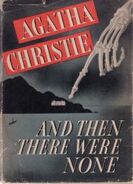
US First Edition encompass.
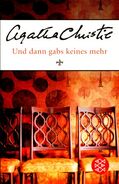
German cover.
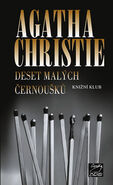
Czech cover.
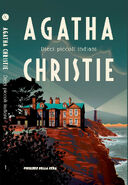
Italian cover.
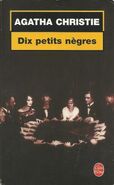
French cover.
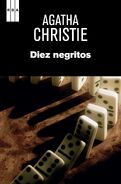
Spanish comprehend.
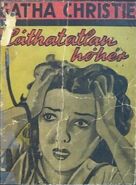
Hungarian cover
External links
- And Then There Were None at the official Agatha Christie website
- Spark Notes for novel
ig
And Then There Were None Guest Profile,
Source: https://agathachristie.fandom.com/wiki/And_Then_There_Were_None
Posted by: sloatextration98.blogspot.com


0 Response to "And Then There Were None Guest Profile"
Post a Comment